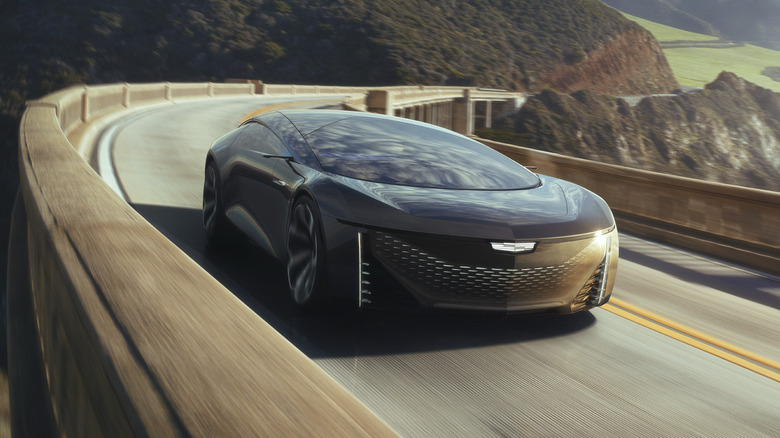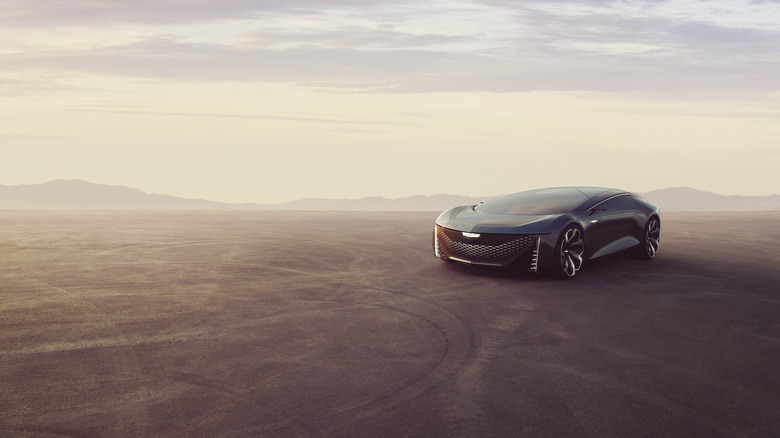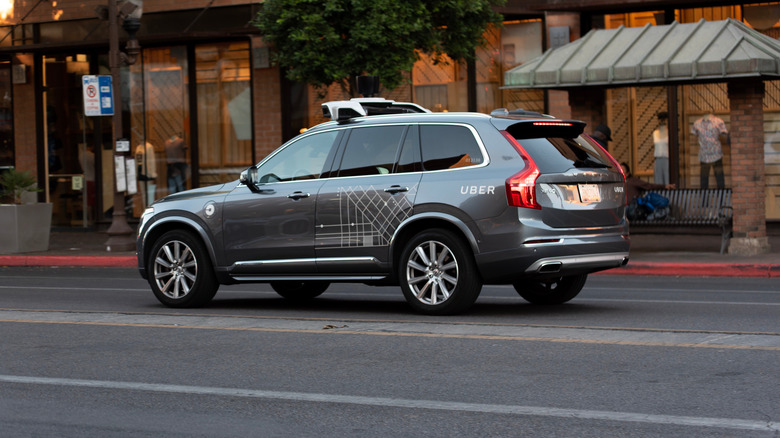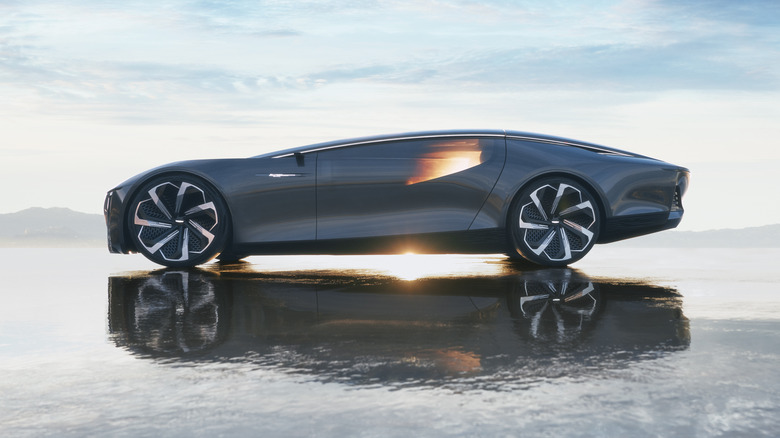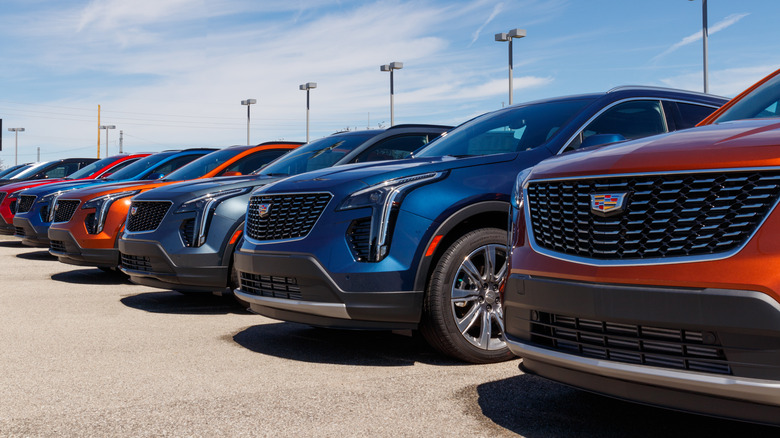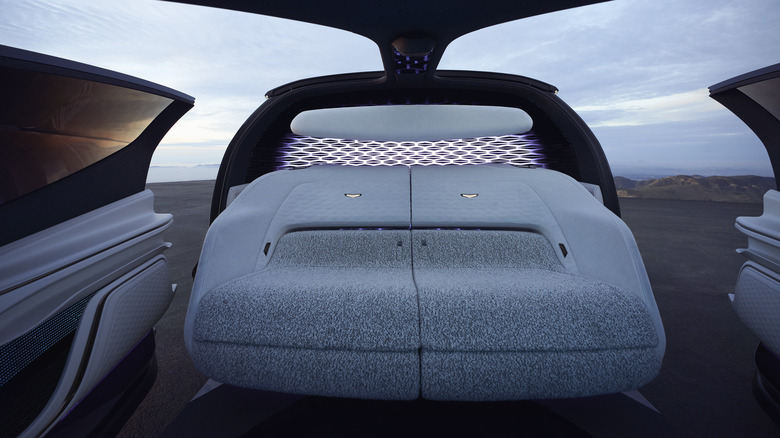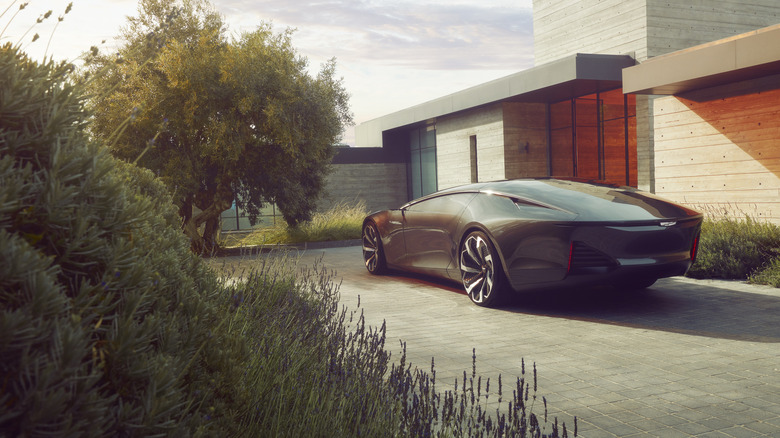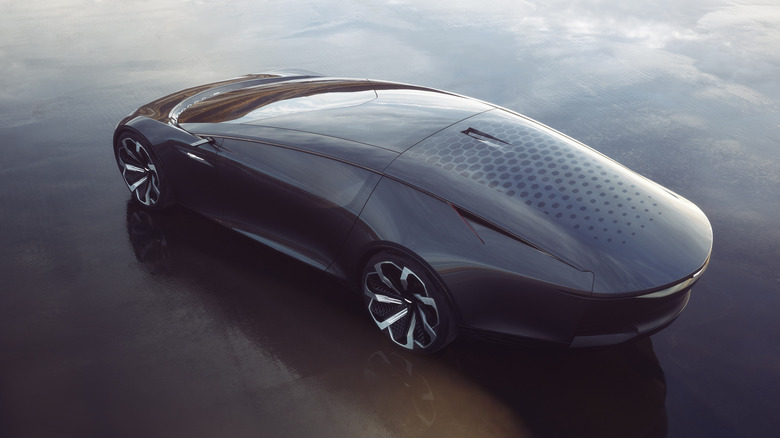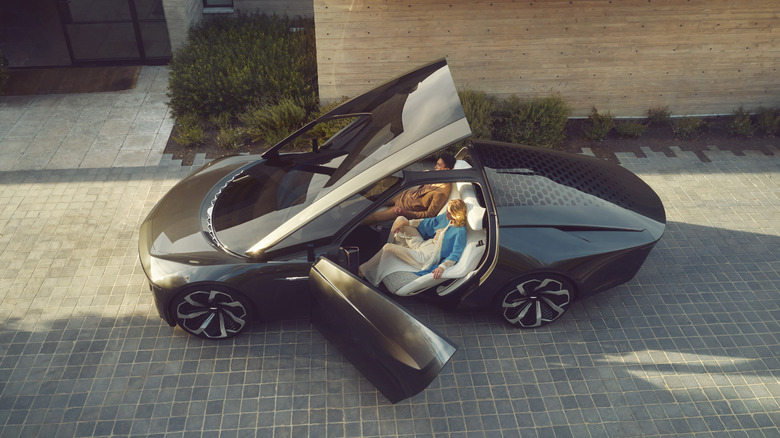10 Reasons You Won't See The Cadillac InnerSpace On The Road Anytime Soon
Cadillac introduced its InnerSpace concept as one of three new designs at CES in 2022, and it certainly caused a stir. The radical look of the concept, sporting a sleek, futuristic shape and many high-tech features, was a world away from Cadillac's stereotypical image as a conservative, heritage-focused automaker. A year on, though, and there are no signs that the InnerSpace, nor either of the other two concepts debuted at the same time, will be making their way onto public roads anytime soon.
This isn't so surprising given that there are a few key flaws with the InnerSpace and other, similar autonomous concepts that mean they might never make it into production form. These flaws concern both the practicalities of a fully self-driving car on ever-changing roadways and the issues that the public at large might take with such a vehicle. In practice, it's unlikely that we'll see anything like the InnerSpace on the roads for the foreseeable future, and here's why.
The limits of fully autonomous vehicles
Perhaps the biggest issue with the idea of a fully-self driving car is the limitations of current autonomous technology. While systems like Tesla's Autopilot and Cadillac's own Super Cruise are mostly capable of driving down highways without human intervention, come away from the main roads and they're not so capable. American cities with grid-like infrastructure are relatively easy for developers to map, and most urban-focused development work has taken place in these environments. Google's Waymo division, for example, launched its first autonomous driving service in Phoenix, Arizona, while Uber's development program (and its fatal crash) took place in nearby Tempe, alongside a separate testing program in California.
However, look at cities in other parts of the world — notably, Europe and Asia — and cities tend to be more cramped, unpredictable, and difficult to navigate. If self-driving cars are to become viable, they'll need to be able to navigate these packed urban environments with near-100% precision, and they simply can't do that right now. Things get even trickier when you leave the city and get out into rural areas, as varied terrain, limited connectivity, and a whole new set of hazards present themselves. While today's best autonomous systems might be good at dealing with a limited set of circumstances, they're nowhere near being able to deal with everything that real-world driving might throw at them.
Constantly changing roads
If dealing with a vast variety of driving environments isn't enough, autonomous cars would also have to constantly adapt to ever-changing road conditions and disruptions. Virtual maps are updated frequently in areas of high traffic, but in rural or other low-volume areas, that's not the case. That could leave self-driving cars with out-of-date perceptions of the environment around them, leading them to miss a recently-built housing development or even try to drive down a road that's been temporarily closed.
That's not to mention, of course, the constant changes brought about by rush hour traffic in cities, or seasonal challenges like ice, snow, or heavy rain. Unusual hazards also present a unique problem that autonomous vehicles would have to face — take, for example, the case of England's Rufford Ford, which recently went viral on social media. A quick look at one of the many video compilations of the ford will prove how many drivers perceive the water's depth and current incorrectly and end up flooding their vehicles, so it seems unlikely that an autonomous car would be able to get it right 100% of the time. All of these systems will likely be improved and optimized over time, but for now, they're a long way from being good enough to the point where no driver input at all is needed.
Regulatory hurdles
Even if autonomous systems can reach the point where they can comfortably navigate through all of these situations, there's the additional problem of proving to regulators that they can actually do what they claim to. During the first few years of autonomous car testing, there were plenty of authorities willing to give the technology a chance. However, Uber's 2018 accident played a big part in dampening that initial wave of enthusiasm.
A Volvo XC90 fitted with Uber's autonomous driving system plowed into a pedestrian who stepped out into the road unexpectedly, leaving her with injuries so severe that she died after being taken to hospital. Analysis of the crash showed that Uber's system had detected her presence, but deemed her to be something that the car should drive through rather than attempt to stop for. Essentially, the car decided to crash straight into her. It's worth noting that, in this case, the car did have a safety driver who was distracted from the road, and she was eventually charged with negligent homicide. However, any fully autonomous car, like the InnerSpace, will have no human input at all. So, the system will have to be trusted to make all the decisions by itself.
Sky-high development costs
All this development and subsequent regulatory approval would come with a vast price tag for GM, a company that's already committed to spending most of its R&D resources developing a new lineup of electric vehicles. It's hard to imagine that bosses would be keen to divert too much cash away from the EV development initiative, especially for a project that would likely appeal to a much smaller section of the market.
Regulators around the world have already put in place legislation to ban the sale of gas-powered vehicles around the year 2035, to meet climate goals that were agreed upon at the COP26 summit. General Motors also pledged to phase out all of its gas cars by 2035 at the same event, so it'll be all hands on deck to meet that goal from this point forward. Autonomous tech simply isn't a priority for GM or most other companies right now, so it'll probably take a backseat, at least until the switch to electric vehicles is complete.
A big pricing problem
Even if, and it's a big if, GM did suddenly decide to sign off on a program to make self-driving cars a reality, the cost of development would make finding a suitable retail price for these cars an almost impossible task. To get anywhere close to recouping its costs, GM would need to set prices much higher than any equivalent non-autonomous luxury car, Cadillac or not. That would put the production InnerSpace in a price bracket all of its own, competing against cars that it likely couldn't match in craftsmanship or prestige.
It's also not clear what segment the InnerSpace would aim to compete in, for example, whether it would aim to attract buyers of the Mercedes S-Class, or position itself even more upmarket to take on the likes of Bentley. Targeting either one would require a build quality and finish far superior to that of the average GM product, and for that matter, considerably better than any current Cadillac on the market. Even then, the added cost of developing full autonomy would mean that GM would likely be working on tighter profit margins than either the German or British manufacturer. The concept itself might be new and innovative, but that innovation comes at a cost, one that will have to be directly reflected in its MSRP.
It's still a Cadillac
This leads nicely into another big sticking point for the Cadillac InnerSpace: it's still very much a Cadillac. For several decades now, the brand's primary strategy has been to appeal to buyers who remember it in its prime, or at least appreciate its heritage. A 2018 study by CarMax showed Cadillac had the oldest buyers of any car brand on the market, with an average age of 47. These are also the buyers who are most likely to be able to afford to fork out for such a high-end car, and are they really going to want a self-driving futuristic pod on wheels?
The answer is, probably not — which begs the question of who exactly the InnerSpace is geared towards. Stereotypically, it's younger buyers who favor innovation, yet they're also the least likely to be persuaded by the Cadillac badge on the front. If GM wants Caddy to appeal to a younger, more tech-oriented generation, it'll first have to undo decades of its own marketing and brand image.
Impractical design
While the InnerSpace's central sofa-style seat is great for occupants to make use of the large curved screen fitted to the front of the cabin, it does pose a greater risk than a traditionally-styled car seat. With passengers able to sit very close together and with little securing them to their seats, there's a chance that they could collide with each other in the case of an accident. This doesn't matter in a flashy concept, of course, but it's something that Cadillac's design team would have to consider before reaching the production stage. Modern seat belts are designed the way that they are for good reason, and the seat's shape and maneuverability would make it tricky to fit an effective one.
Another impractical feature is the doors and roof, which open both upwards and outwards when the occupants get out of the car. That setup leaves it vulnerable to rain or snow getting in, and might even become non-functional in places where heavy snowfall is a regular occurrence.
A frosty public reception
Another issue that, perhaps understandably, makers of autonomous car concepts can be reluctant to discuss is whether there's enough demand in the market for a fully self-driving vehicle in the first place. Semi-autonomous systems have already proved to be popular in certain segments, but making the step to full autonomy requires giving up the ability to manually control the car at all.
A 2017 study by MIT showed that nearly half of the respondents would never want to own a self-driving car, with increasing numbers of younger people no longer comfortable with the idea. In 2022, Pew Research Center found that 44% of Americans thought the widespread use of self-driving cars would be bad for society, with only 26% thinking it would be a good thing. In addition, over 60% of adults said that they wouldn't want to ride in an autonomous car if given the opportunity, with that figure rising with the age of the respondent. And remember, there's a good chance that older people will make up the vast majority of buyers wealthy enough to own one in the first place.
Legal implications
Assuming self-driving cars can pass all of these hurdles and get onto public roads in the first place, there's still the legal issue of whose fault it is if said self-driving car is involved in an accident. Let's say an InnerSpace, which has no way for the occupants to take control at any time, hits a pedestrian and kills them (like Uber did in 2018). Who bears the responsibility for the crash? The car's occupants will be focused on enjoying their "wellness experiences" if Cadillac's press release is anything to go by, so they won't be looking at the road. Even if they were, there's no way for them to stop the car. Surely then, it can't be their fault if an accident happens.
There are two other main parties that could shoulder the blame: insurers or Cadillac itself. Cadillac certainly isn't going to want to take on that responsibility on its own, so that's out of the question. Whether insurers are willing to take on the risk of paying out for the actions of an AI system remains to be seen, but let's face it, it's costly enough trying to get them to insure humans. It's arguable that an autonomous fleet of cars would eventually be safer, but this assumes their systems will be vastly more capable than today. Plus, as long as there are unpredictable human drivers on the road, there will still be plenty of accidents (and as a result, costly lawsuits) to deal with.
Fire safety concerns
If all that still isn't enough to dampen your enthusiasm for the InnerSpace, commenters on TikTok pointed out one final issue with the futuristic concept. The doors and roof look great when they open outwards, but there doesn't seem to be any way to manually open them from the inside. Sure, in a show-only car this isn't an issue, but in the real world, not being able to get out of the car after an accident could have some pretty nasty consequences.
The biggest of those would be the risk of fire, especially since battery-electric vehicles have proven themselves to be just as temperamental as gas-powered cars when it comes to roadside combustion. Not only that, but when an EV catches fire, it's more difficult for fire crews to stop than a combustion-powered car. The InnerSpace's themes of wellness and relaxation might be great in theory, but the litany of flaws with the idea means that it would be anything but relaxing to ride in one on public roads.
